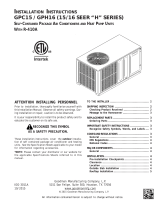
3
WARNING:
The information listed below must be followed
during the installation, service, and operation
of this unit. Unqualified individuals should not
attempt to interpret these instructions or install
this equipment. If you do not posses mechanical
skills or tools, call your local dealer for assistance.
Failure to follow safety recommendations could
result in possible damage to the equipment,
serious personal injury or death.
• The installer must comply with all local codes and
regulations which govern the installation of this type of
equipment. Local codes and regulations take precedence
over any recommendations contained in these instructions.
Consult local building codes and the National Electrical
Code (ANSI CI) for special installation requirements.
• Allelectricalwiringmustbecompletedinaccordancewith
local, state and national codes and regulations and with
the National Electric Code (ANSI/NFPA 70) or in Canada
the Canadian Electric Code Part 1 CSA C.22.1.
• Thisequipmentcontainsliquid andgaseous refrigerant
under high pressure. DO NOT USE ANY PORTION OF THE
CHARGE FOR PURGING OR LEAK TESTING. Installation
or servicing should only be performed by qualified trained
personnel thoroughly familiar with this type equipment.
• Use caution when handling this appliance or removing
components. Personal injury can occur from sharp metal
edges present in all sheet metal constructed equipment.
• This unit is designed for outdoor installations only and
should be located in a position as shown on page 3.
• Followall precautionsin theliterature, ontags, andon
labels provided with the equipment. Read and thoroughly
understand the instructions provided with the equipment
prior to performing the installation and operational checkout
of the equipment.
• Theinstallershouldbecomefamiliarwiththeunitswiring
diagram before making any electrical connections to the
unit. See the unit wiring label or Figure 12 (page 14),
Figure 13 (page 15), or Figure 14 (page 16).
GENERAL INFORMATION
This air conditioner is designed only for outdoor ground
level installations and can be readily connected to the high
static duct system of a home. This unit has been tested for
capacity and efficiency in accordance with AHRI Standards
and will provide many years of safe and dependable comfort,
providing it is properly installed and maintained. Abuse,
improper use, and/or improper maintenance can shorten the
life of the appliance and create unsafe hazards.
Before You Install this Unit
√ The cooling load of the area to be conditioned must be
calculated and a system of the proper capacity selected.
It is recommended that the area to be conditioned be
completely insulated and vapor sealed.
√ Check the electrical supply and verify the power supply
is adequate for unit operation. If there is any question
concerning the power supply, contact the local power
company.
√ All units are securely packed at the time of shipment and
upon arrival should be carefully inspected for damage prior
to installing the equipment at the job site. Verify coil fins
are straight. If necessary, comb fins to remove flattened or
bent fins. Claims for damage should be filed immediately
with the carrier.
√ Please consult your dealer for maintenance information
and availability of maintenance contracts. Please read all
instructions before installing the unit.
Locating the Air Conditioner
• Survey the job site to determine the best location for
mounting the outdoor unit. Select a solid, level position,
preferably on a concrete slab, slightly above the grade
level, and parallel to the home. If possible, select a site
for the unit that is as close as possible to the proposed
return grille location. DO NOT PLACE UNIT UNDER THE
HOME.
• Theunitshouldbelocatedwithconsiderationofminimizing
the length of the supply and return ducts. If practical, place
the air conditioner and its ducts in an area where they will
be shaded from the afternoon sun, when the heat load is
greatest.
• Thelengthofthesupplyandreturnductsshouldbekept
to a minimum with no sharp radius bends.
• Overheadobstructions,poorlyventilatedareas,andareas
subject to accumulation of debris should be avoided. The
hot condenser air must be discharged up and away from
the home, and if possible, in a direction with the prevailing
wind. Do not place the unit in a confined space.
• Considerationshouldalsobegiventoavailabilityofelectric
power, service access, noise, and shade.




















